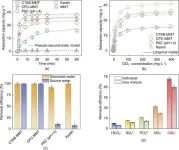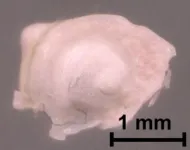We must not ignore eugenics in our genetics curriculum, says professor
2025-03-27
(Press-News.org) To encourage scientists to speak up when people misuse science to serve political agendas, biology professor Mark Peifer of the University of North Carolina at Chapel Hill argues that eugenics should be included in college genetics curriculums. In an opinion paper publishing March 27 in the Cell Press journal Trends in Genetics, Peifer explains how he incorporated a discussion of eugenics into his molecular genetics course last year and why understanding the history of the field is critical for up-and-coming scientists.
“Eugenics is not dead but continues to influence science and policy today,” writes Peifer (@peiferlabunc, @peiferlabunc.bsky.social). “We should include eugenics in our undergraduate classes, reminding students that scientists must speak out when others lie about science and use it to further their political views.”
In his genetics course, Peifer led his students through the history of eugenics—a term that was coined in 1883 to describe the practice of promoting planned breeding for “racial improvement.” He explained how the idea gained global popularity during the 20th century and was used to justify forced sterilization, racist immigration policies, and genocide in Nazi Germany. The class also covered how eugenics was championed scientifically by some of the founding fathers of genetics and molecular biology—including James Watson, one of the scientists who co-discovered the structure of DNA.
“The core ideas of eugenics are not things of the past—they fuel current political discourse, as political candidates talk about ‘good genes’ and ‘bad genes’ and suggest immigration is ‘poisoning the blood of our country,’” writes Peifer. “Science provides technology, but society decides how to use it.”
To illustrate the relevance of eugenics in today’s world, Peifer ended the class by asking the students to discuss a series of questions surrounding in vitro fertilization (IVF) and embryo screening: Should we allow IVF? Should we allow embryo screening for cystic fibrosis? Should we allow screening for chromosomal sex? Should we allow screening for height?
“Some might argue that with all the complex topics to cover, we don’t have time for a historical discussion with political overtones on our syllabi,” writes Peifer. “I think the centrality of genetics to society, the lives of our students, and their ability to make thoughtful choices make discussing eugenics critical. Our students will also be citizens and will help friends and family navigate complex decisions with science at their base.”
###
Trends in Genetics, Peifer, “We must not ignore eugenics in our genetics curriculum.” https://www.cell.com/trends/genetics/fulltext/S0168-9525(25)00028-9
Trends in Genetics (@TrendsGenetics), published by Cell Press, is a monthly review journal that provides researchers and students with high-quality, novel reviews, commentaries, and discussions to foster an appreciation for the advances being made on all fronts of genetic research. Visit http://www.cell.com/trends/genetics. To receive Cell Press media alerts please contact press@cell.com.
END
ELSE PRESS RELEASES FROM THIS DATE:
2025-03-27
About The Study: The results of this cohort study suggest that semaglutide use was associated with an increased risk of nonarteritic anterior ischemic optic neuropathy in patients with diabetes. However, the study’s retrospective design presents limitations, as it can only infer associations rather than establish causality; further studies are needed.
Corresponding Authors: To contact the corresponding authors, email Chun-Ju Lin, MD (doctoraga@gmail.com) and James Cheng-Chung ...
2025-03-27
About The Study: Daily screen use was associated with later bedtimes and approximately 50 minutes less sleep each week in this study. Associations were greater among those with evening chronotypes, who are at risk for poor sleep due to social jetlag (i.e., misalignment between circadian rhythms and social commitments). These findings confirm disruptions to sleep from electronic screens are not limited to children and adolescents. Further work is needed to understand the best mechanisms for intervention.
Corresponding Author: To ...
2025-03-27
About The Study: In this pooled cross-sectional study, findings suggest that state legislatures that elected to increase their state minimum wage may have also improved state food security rates among households with children at risk for economic hardship. The findings provide policymakers with actionable evidence to consider in setting minimum wages that could reduce the burden of food insecurity among U.S. children and families.
Corresponding Author: To contact the corresponding author, Megan R. Winkler, PhD, RN, email megan.winkler@emory.edu.
To ...
2025-03-27
A study published in Engineering introduces an innovative approach to address the issue of perchlorate (ClO4−) contamination in water. Perchlorate is a harmful oxo-anion found in aquatic environments. It can enter the human body through drinking water and inhibit iodine absorption in the thyroid gland, potentially causing various thyroid-related diseases. Given the strict perchlorate limits in drinking water worldwide, such as 70 μg/L in China and 15 μg/L in the United States, developing efficient methods for its removal is crucial.
The research team, hailing from Hunan University and Shanghai Jiao Tong University, prepared an adsorbent ...
2025-03-27
WASHINGTON — For the first time, researchers have shown that terahertz imaging can be used to visualize internal details of the mouse cochlea with micron-level spatial resolution. The non-invasive method could open new possibilities for diagnosing hearing loss and other ear-related conditions.
“Hearing relies on the cochlea, a spiral-shaped organ in the inner ear that converts sound waves into neural signals,” said research team leader Kazunori Serita from Waseda University in Japan. “Although conventional imaging methods often struggle to visualize this organ’s fine details, ...
2025-03-27
(WASHINGTON—March 27, 2025) — A machine learning model generated by a team from the European Society for Blood and Marrow Transplantation (EBMT) outperformed standard statistical models in identifying and stratifying transplant risk for patients with myelofibrosis, according to new research published today in Blood, the American Society of Hematology’s flagship journal.
“Although there are many models available to identify patients with high-risk myelofibrosis, we are still lacking ...
2025-03-27
Accurate and robust 3D imaging of specular, or mirror-like, surfaces is crucial in fields such as industrial inspection, medical imaging, virtual reality and cultural heritage preservation. Yet anyone who has visited a house of mirrors at an amusement park knows how difficult it is to judge the shape and distance of reflective objects.
This challenge also persists in science and engineering, where the accurate 3D imaging of specular surfaces has long been a focus in both optical metrology and computer vision research. While specialized techniques ...
2025-03-27
Noted Maya archaeologist Julie Hoggarth, Ph.D., associate professor of anthropology at Baylor University, has been elected to the rank of AAAS Fellow, a lifetime honor announced today by the Council of the American Association for the Advancement of Science (AAAS), the world’s largest general scientific society and publisher of the Science family of journals.
Hoggarth is among the 471 scientists, engineers and innovators who have been elected 2024 Fellows for their scientifically and socially distinguished achievements throughout their careers. The new Fellow class hails from academic institutions, ...
2025-03-27
DALLAS, March 27, 2025 — Recent analysis by the National Health Institute indicates that telehealth now accounts for 23% of all health care encounters nationwide, with some clinical specialties reporting virtual visit rates now exceeding 50%.[1] To help ensure quality care in this rapidly expanding field, the American Heart Association Center for Telehealth and the National Institutes of Health-funded University of North Carolina Chapel Hill Center for Virtual Care Value and Excellence (UNC-Chapel Hill ViVE), are building ...
2025-03-27
FOR IMMEDIATE RELEASE
Contact:
Raluca Cadar
The Protein Society
Phone: (844) 377-6834
E-mail: rcadar@proteinsociety.org
LOS ANGELES, CA – The Protein Society, the premier international society dedicated to supporting protein research, announces the winners of the 2025 Protein Society Awards, which will be recognized at the 39th Annual Symposium, June 26 – 29, 2025, in San Francisco, USA. Plenary talks from award recipients will take place throughout the 3.5-day event. The winners’ scientific accomplishments, described by their nominators below, demonstrate their profound impact on protein science.
The Christian B. Anfinsen ...
LAST 30 PRESS RELEASES:
[Press-News.org] We must not ignore eugenics in our genetics curriculum, says professor



